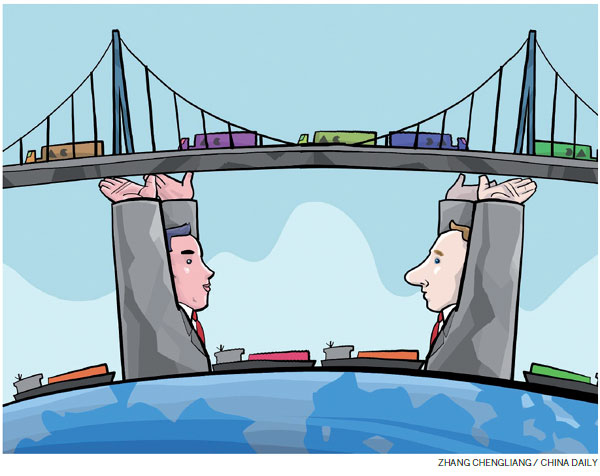The road to better Asia-Europe links
Opportunities are present, and should be used, for a productive dialogue on improving transportation connectivity between the two continents.
By Young Tae Kim
Since China launched the Belt and Road Initiative in 2013, the transportation links between Europe and Asia have been in the public spotlight. Eurasian connectivity has become a hot topic for businesses, policymakers and journalists.

Better international transportation links benefit everyone. Good physical connectivity is the key to enhanced trade. It makes it easier for domestic companies to sell to overseas markets, and it helps them to produce more efficiently through access to a broader range of raw materials and other inputs. Well-connected countries attract more foreign investment, since connectivity is so important for businesses' choice of location. In short, enhancing connectivity serves the common good.
Yet connectivity improvements on an international level need to be exceedingly well planned, carefully coordinated and professionally managed. By definition, they link what so far was not (well) connected - different economic and political systems, legal traditions and technical standards. Much more needs to come together than train tracks with different gauges.
Finding the necessary common ground can only happen through dialogue. Building trust among all involved, establishing common principles to work from and a joint vision to work toward are the three keys to success. The Summit of the Asia-Europe Meeting in Brussels on Oct 18 was an excellent opportunity to take the dialogue between the Asian and European partners to a new level, coming only weeks after the European Union unveiled its own strategic framework for developing Eurasian connectivity.
Europe has been relatively slow to develop a Eurasian strategy, and some see the EU's initiative as an attempt to push back against perceived geopolitical ambitions of others. That may or may not be part of the story. But it would be a strategic mistake to frame the narrative of Eurasian connectivity as one of strategic competition or even potential conflict. Instead, it ought to be a cast as a historic opportunity for both regions, whose connections go back millennia.
Until now, the Belt and Road Initiative resembled China drilling a tunnel through a mountain on its own. Now the Europeans are also shoveling from the other side. In principle, the result should be that we can reap the benefits of improved Eurasian connectivity. Yet if the fundamentals are not aligned now, the two tunnel ducts might just pass each other somewhere underground without ever meeting. Instead of a breakthrough, effort would be wasted and benefits lost.
Europe has much to offer for developing Eurasian connectivity. The funds it can muster may be less impressive than those that China has at its disposal. The money available through mechanisms like the European Fund for Strategic Investments or the Connecting Europe Facility is still considerable, however, and will help to advance strategic projects of mutual interest.
More important, the EU has more than six decades of experience in regulating regional and interregional connectivity. Creating seamless cross-border links is its core business. In fact, connecting the people of Europe with each other, in the broadest sense, was the very reason for the creation of the EU. Today, there are few if any multilateral arrangements that are better at it. The trans-European networks, established in 1991 after the political and economic division of Europe ended, are proof of this. The networks have greatly enhanced physical connectivity within the enlarged EU and are now being extended beyond the EU's borders.
This is something to build on. The moment has come for Europe and Asia to align their visions, now that the EU has laid out its own Eurasia connectivity strategy. This will inevitably mean compromise. The Europeans want connectivity between the continents to be sustainable, comprehensive and rules-based. Similarly, the Association of Southeast Asian Nations' connectivity masterplan stresses sustainable infrastructure and regulatory excellence. Both think additional efforts in this direction are necessary. There now needs to be a political process for fundamental alignment.
The ASEM Summit in Brussels was a good start for taking this forward. Some practical tools to support evidence-based decision-making have been put in place, such as the Connectivity Platform, a data set to measure the quantity and quality of connections, and the Connectivity Inventory, an overview of lessons learned and ideas on how to deepen policies and drive action. The International Transport Forum and the Organization for Economic Cooperation and Development are examining ways to enhance connectivity for Central Asia that can also contribute valuable guidance for policy decisions.
In May, the International Transport Forum will host transportation ministers from its 59 member countries and invited countries, many from the region, for a Summit on Transport Connectivity for Regional Integration. This will provide the next opportunity to deepen the dialogue on how to shape Europe-Asia connectivity, at a halfway point between the Brussels Summit and the upcoming ASEM Transport Ministers Meeting in Hungary in the second half of 2019. The International Transport Forun Summit will be held under the presidency of the Republic of Korea, which is negotiating to re-establish rail and road links with the Democratic People's Republic of Korea as part of the peace process - another geo-strategic opportunity to use transportation to advance peace, rather than rivalry.
The opportunities for a productive dialogue on improving transportation connectivity between Asia and Europe are there. Let us use them, for the benefit of citizens in both regions.
The author is secretary-general of the International Transport Forum at the OECD. The ITF is an intergovernmental organization with 59 member countries.

